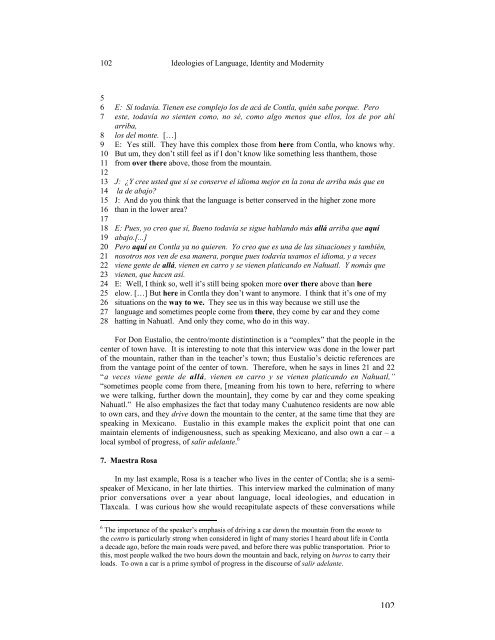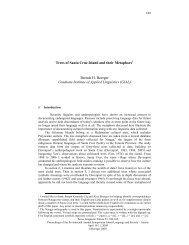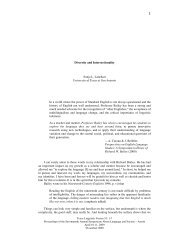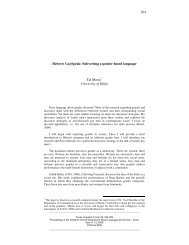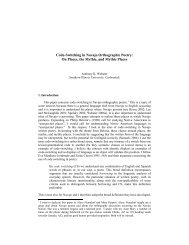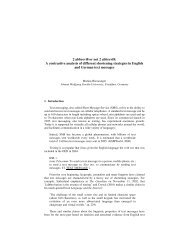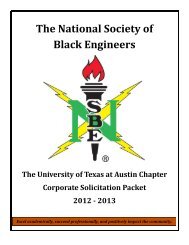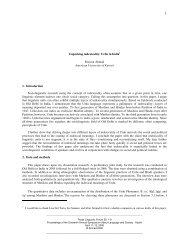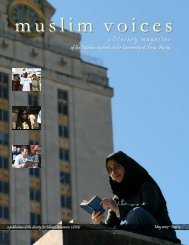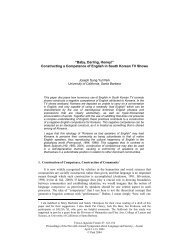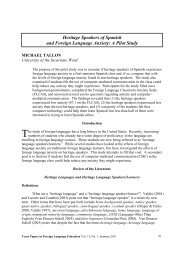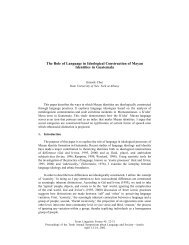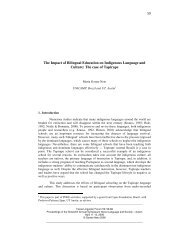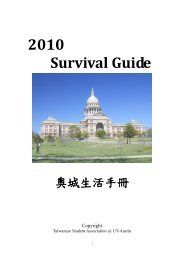Fractal Recursivity in Ideologies of Language, Identity and Modernity ...
Fractal Recursivity in Ideologies of Language, Identity and Modernity ...
Fractal Recursivity in Ideologies of Language, Identity and Modernity ...
Create successful ePaper yourself
Turn your PDF publications into a flip-book with our unique Google optimized e-Paper software.
102<br />
<strong>Ideologies</strong> <strong>of</strong> <strong>Language</strong>, <strong>Identity</strong> <strong>and</strong> <strong>Modernity</strong><br />
5<br />
6 E: Sí todavía. Tienen ese complejo los de acá de Contla, quién sabe porque. Pero<br />
7 este, todavía no sienten como, no sé, como algo menos que ellos, los de por ahí<br />
arriba,<br />
8 los del monte. […]<br />
9 E: Yes still. They have this complex those from here from Contla, who knows why.<br />
10 But um, they don’t still feel as if I don’t know like someth<strong>in</strong>g less thanthem, those<br />
11 from over there above, those from the mounta<strong>in</strong>.<br />
12<br />
13 J: ¿Y cree usted que sí se conserve el idioma mejor en la zona de arriba más que en<br />
14 la de abajo?<br />
15 J: And do you th<strong>in</strong>k that the language is better conserved <strong>in</strong> the higher zone more<br />
16 than <strong>in</strong> the lower area?<br />
17<br />
18 E: Pues, yo creo que sí, Bueno todavía se sigue habl<strong>and</strong>o más allá arriba que aquí<br />
19 abajo.[...]<br />
20 Pero aquí en Contla ya no quieren. Yo creo que es una de las situaciones y también,<br />
21 nosotros nos ven de esa manera, porque pues todavía usamos el idioma, y a veces<br />
22 viene gente de allá, vienen en carro y se vienen platic<strong>and</strong>o en Nahuatl. Y nomás que<br />
23 vienen, que hacen así.<br />
24 E: Well, I th<strong>in</strong>k so, well it’s still be<strong>in</strong>g spoken more over there above than here<br />
25 elow. […] But here <strong>in</strong> Contla they don’t want to anymore. I th<strong>in</strong>k that it’s one <strong>of</strong> my<br />
26 situations on the way to we. They see us <strong>in</strong> this way because we still use the<br />
27 language <strong>and</strong> sometimes people come from there, they come by car <strong>and</strong> they come<br />
28 hatt<strong>in</strong>g <strong>in</strong> Nahuatl. And only they come, who do <strong>in</strong> this way.<br />
For Don Eustalio, the centro/monte dist<strong>in</strong>t<strong>in</strong>ction is a “complex” that the people <strong>in</strong> the<br />
center <strong>of</strong> town have. It is <strong>in</strong>terest<strong>in</strong>g to note that this <strong>in</strong>terview was done <strong>in</strong> the lower part<br />
<strong>of</strong> the mounta<strong>in</strong>, rather than <strong>in</strong> the teacher’s town; thus Eustalio’s deictic references are<br />
from the vantage po<strong>in</strong>t <strong>of</strong> the center <strong>of</strong> town. Therefore, when he says <strong>in</strong> l<strong>in</strong>es 21 <strong>and</strong> 22<br />
“a veces viene gente de allá, vienen en carro y se vienen platic<strong>and</strong>o en Nahuatl,”<br />
“sometimes people come from there, [mean<strong>in</strong>g from his town to here, referr<strong>in</strong>g to where<br />
we were talk<strong>in</strong>g, further down the mounta<strong>in</strong>], they come by car <strong>and</strong> they come speak<strong>in</strong>g<br />
Nahuatl.” He also emphasizes the fact that today many Cuahutenco residents are now able<br />
to own cars, <strong>and</strong> they drive down the mounta<strong>in</strong> to the center, at the same time that they are<br />
speak<strong>in</strong>g <strong>in</strong> Mexicano. Eustalio <strong>in</strong> this example makes the explicit po<strong>in</strong>t that one can<br />
ma<strong>in</strong>ta<strong>in</strong> elements <strong>of</strong> <strong>in</strong>digenousness, such as speak<strong>in</strong>g Mexicano, <strong>and</strong> also own a car – a<br />
local symbol <strong>of</strong> progress, <strong>of</strong> salir adelante. 6<br />
7. Maestra Rosa<br />
In my last example, Rosa is a teacher who lives <strong>in</strong> the center <strong>of</strong> Contla; she is a semispeaker<br />
<strong>of</strong> Mexicano, <strong>in</strong> her late thirties. This <strong>in</strong>terview marked the culm<strong>in</strong>ation <strong>of</strong> many<br />
prior conversations over a year about language, local ideologies, <strong>and</strong> education <strong>in</strong><br />
Tlaxcala. I was curious how she would recapitulate aspects <strong>of</strong> these conversations while<br />
6 The importance <strong>of</strong> the speaker’s emphasis <strong>of</strong> driv<strong>in</strong>g a car down the mounta<strong>in</strong> from the monte to<br />
the centro is particularly strong when considered <strong>in</strong> light <strong>of</strong> many stories I heard about life <strong>in</strong> Contla<br />
a decade ago, before the ma<strong>in</strong> roads were paved, <strong>and</strong> before there was public transportation. Prior to<br />
this, most people walked the two hours down the mounta<strong>in</strong> <strong>and</strong> back, rely<strong>in</strong>g on burros to carry their<br />
loads. To own a car is a prime symbol <strong>of</strong> progress <strong>in</strong> the discourse <strong>of</strong> salir adelante.<br />
102


